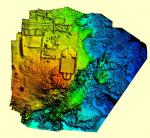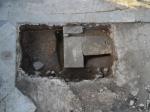Summary (English)
Introduction
In 2015, the University of Padova carried out a first campaign of excavations in the Sanctuary of Eshmun (Aesclepius), situated at the southernmost point of the Nora peninsula (Capo di Pula). Gennaro Pesce carried out the first excavations between 1952-1960, and 1992 Sandro Bondi also excavated on the site.
The 2015 excavations concentrated on the eastern part of the temple’s pronaos and the entry courtyard with mosaic floor to the north of the pronaos.The pronaos
The excavation of the pronaos exposed several parts of the opus signinum floor with two layers of make-up. The latter contained pottery suggesting a construction date within the first half of the 3rd century A.D. Five steps leading from the mosaic courtyard to the pronaos also belong to this phase. A large robber trench was situated at the top of the steps interpreted as the foundation trench for an upright (column or pillar) thus suggesting a reconstruction with two pillars in antis for the facade.
The robber trench of the threshold that led from the pronaos into the cella was also identified. Numerous pieces of marble from different parts of the Mediterranean were found at this point, the remains of the cella’s opus sectile floor.
In the central part of the trench, the excavation also exposed traces of a floor made of beaten and then smoothed lime, dating to a Republican phase of the complex. Lastly, close to this area, a structure of squared stones connected with the east-west Punic wall in squared sandstone blocks, although only partially exposed, suggests the presence of a monumental building probably of Punic date.The courtyard
A second trench was opened in the area of the large mosaic courtyard situated between the northern edge of the sanctuary and the steps leading to the pronaos. The courtyard was paved with a geometric polychrome mosaic thought to date to the mid imperial period. The restoration carried out last century had not repaired a vast lacuna present in the western part of the area.
A 2.5 × 1.5 m sondage was opened revealing the make-up layers for the mosaic floor. Below these were the tops of several dry-stone walls built in large sandstone blocks placed perpendicularly to each other and which ran perpendicularly and parallel to the other structures situated south of the trench, between the courtyard and the pronaos, and predating the Roman buildings. These structures were connected to stratigraphy that produced Hellenistic and pre-Hellenistic materials. The lower levels situated above the bedrock (andesite) were cut by two foundation trenches created for the sandstone block structures. These levels did not produce any black glaze pottery, but only ceramics datable to the Phoenician and Punic periods. It is therefore possible to suggest that this albeit small section of structure was part of a pre-Roman sacred monumental complex.
- Jacopo Bonetto Università degli Studi di Padova - Dipartimento dei Beni Culturali
- Alessandra Marinello- Università degli Studi di Padova - Dipartimento dei Beni Culturali
Director
Team
- Valeria De Scarpis de Vianino- Università degli Studi di Padova - Dipartimento dei Beni Culturali
- Luca Zamparo- Università degli Studi di Padova - Dipartimento dei Beni Culturali
Research Body
- Comune di Pula
- Soprintendenza Archeologia della Sardegna
- Università degli Studi di Padova - Dipartimento dei Beni Culturali






![Download [PDF]](/excavation/skins/fasti/images/results/download_sml.png)



